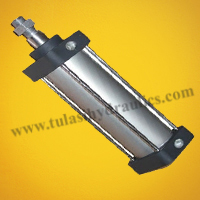Hydraulic Ram Cylinder
Tulasi Hydraulic Pvt.Ltd. is a leading of high-quality Manufactures and Suppliers Hydraulic Ram Cylinders, based in Mumbai, with operations extending to Navi Mumbai and Thane. As a trusted Provider and Exporter, we specialize in fabricating innovative Hydraulic solutions tailored to meet the diverse needs of our clients. Our Manufacturing company prides itself on delivering durable and reliable products, establishing us as a preferred Dealer in the industry. With a commitment to excellence, Tulasi Hydraulic Pvt.Ltd. continues to set the standard for Hydraulic equipment in India and beyond.
A hydraulic ram cylinder, often referred to as a hydraulic ram or simply a ram, is a hydraulic actuator that converts hydraulic fluid pressure into linear mechanical force and motion. Hydraulic ram cylinders are commonly used in various industrial applications where large forces or movements are required. They consist of a piston inside a cylindrical housing and rely on the pressure difference between the hydraulic fluid on one side of the piston and the other to generate force. The cylinder barrel is the outer cylindrical housing that contains the piston and hydraulic fluid. It provides structural support to the cylinder assembly. The piston is a cylindrical component that moves inside the cylinder barrel. It is connected to the rod and is responsible for generating linear force and motion when subjected to hydraulic pressure. The rod, also known as the piston rod or shaft, extends from the piston through one end of the cylinder barrel. It is the part of the cylinder that connects to the load or the application requiring linear motion. The rod transmits the force generated by the piston to the external load.
Hydraulic ram cylinders are equipped with sealing mechanisms to prevent hydraulic fluid leakage. These seals, including piston seals, rod seals, and wiper seals, are essential to maintain pressure and protect the internal components from contaminants. Hydraulic fluid enters and exits the cylinder through hydraulic ports located in the end caps or the cylinder barrel. These ports are connected to the hydraulic system and control the flow of fluid into and out of the cylinder. Hydraulic rams have two end caps, one at each end of the cylinder barrel, that securely seal the hydraulic fluid inside the cylinder. These end caps are often made of durable materials, such as steel or cast iron. Hydraulic ram cylinders can be mounted in various orientations and configurations to suit the application's requirements. Common mounting options include clevis mounts, flange mounts, and base mounts. The load attachment or end fitting is the part of the rod that connects to the load or application being moved or acted upon. Load attachments can vary in design depending on the specific application. Hydraulic rams are used in construction machinery for tasks such as excavating, lifting, and positioning. They are employed in agricultural equipment like tractors and plows for tasks such as raising and lowering implements. Hydraulic rams are used in forklifts, conveyor systems, and other material handling equipment for lifting and positioning loads. They are used in various automotive assembly and testing equipment. Hydraulic rams are used in oil and gas drilling equipment and wellhead control systems. They are found in manufacturing processes that require precise linear movement, such as metal stamping and forming.

Application :
- As per ISO Standard
- Tierod construction as well as welded construction.
- Min. bore O 25 mm to Max. bore 5771 mm.
- Working pressure. a) 140 kg/cm2, b) 350 kg/cm2
- Stroke length upto 6.5 metres
- Telescopic cylinders as per customer’s requirements.
- Cylinders available. In S S For Pharmaceutical Machinery.



